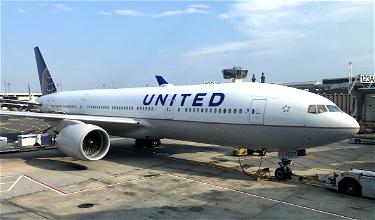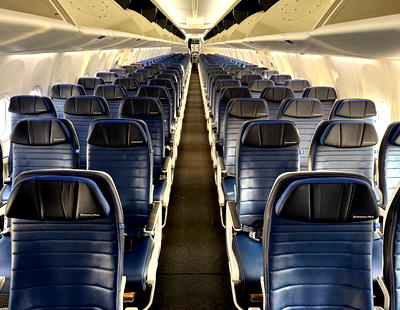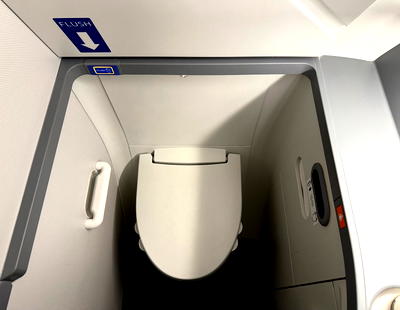Yesterday a United Airlines Boeing 777-200 flying from Denver to Honolulu suffered a major engine failure shortly after takeoff. Significant chunks of the right engine fell to the ground, with one part of the engine falling through the roof of a house, just a couple of feet from someone who was in their kitchen. Thanks to the great work of the pilots (and some luck based on where the debris fell), no one seems to have been seriously injured.
While this is without a doubt a coincidence, I can’t help but point out the interesting plane that ended up replacing the original 777, after the first plane returned to Denver.
In this post:
United Airlines replaces N772UA with N773UA
The plane that was supposed to operate the original Denver to Honolulu flight yesterday had the registration code N772UA. This was the fifth Boeing 777 ever produced, and it joined United’s fleet in 1994.
After the emergency the plane returned to Denver, and United operated a replacement Denver to Honolulu flight for those who still wanted to travel (I imagine some people chose not to fly). This flight operated without issues, and landed in Honolulu about six hours after the originally scheduled flight was supposed to arrive.

The replacement flight used the flight number UA3025. The aircraft that United used for this flight was also a Boeing 777-200, and it had the registration code N773UA. This was the fourth 777 ever produced, and it joined United’s fleet in 1994 as well.

Why is this noteworthy? Because this exact plane had a similar incident in February 2018, also on a flight to Honolulu (though out of San Francisco, rather than Denver). Parts of the right engine fell off over the Pacific. The major difference in the appearance of the engines was that in 2018 there weren’t flames coming from the right engine.
Here’s video footage of that incident at the time:
And here’s the ATC audio:
What an investigation of that incident revealed
The National Transportation Safety Board (NTSB) investigation into the February 2018 incident found that inspections of the engines had failed to spot signs that the fan blades were weak. It was decided that Pratt & Whitney didn’t provide a formal program for training inspectors who examined fan blades.
One of the reasons aviation is so safe is because aviation authorities, airlines, and aircraft and engine manufacturers, learn from each incident. It’s way too early to know what happened with UA328 yesterday, though hopefully it wasn’t caused by a similar issue (in the sense that hopefully something was learned from the 2018 incident).
Let me be clear about what I’m not saying…
I just want to be very clear, I’m not in any way suggesting that there’s anything unsafe about the replacement aircraft, or that either plane is cursed, or that 25+ year old 777s are bad, or anything. Rather I’m just pointing out that:
- United had a similar(ish) incident back in 2018, in terms of a significant chunk of the right engine of a 777 falling off during flight; this was the only other time something like this happened on a United 777
- The exact aircraft that had the incident back in 2018 was used as the replacement aircraft, and was a plane that United took delivery of around the same time
- I’ll be curious to see what the NTSB determines the cause of this incident to be; hopefully it’s not the same as the cause of the 2018 incident
I should also mention that while United has 74 Boeing 777-200s, about a quarter of them belong to a subfleet used primarily for high-density domestic flights. So presumably when United was looking for a replacement aircraft, it wanted a 777 with a similar layout.
Bottom line
Following the incident on UA328 yesterday, United quickly found a replacement aircraft with the same configuration. What’s interesting is that the replacement 777-200 suffered a similar incident about three years ago, also on a flight to Hawaii.
That’s obviously just a coincidence. The NTSB investigation into the previous incident wrapped up in 2020, and determined that the incident occurred due to fan blades not being properly inspected. I’ll be curious to see what the cause of this incident is determined to be… though we may have to wait a couple of years to get a final report.





At the conclusion of the investigation into the 2021 incident, it was determined that inadequate inspection procedures led to the catastrophic failure of a turbine blade while in flight.
In other words, the exact same issue, on the exact same make, with the exact same model of engine, three years apart, on roughly the same heading, going to the same airport.
1994 was a long time ago in aviation years. The design life of these engines boils down to mathematical estimates and real life equations. The airlines are going to fly them until the govt. says they can't .....or they break, whichever comes first.
For UAL to replace this airplane with a sistership 1 serial number different that has ALREADY HAD THE SAME FAILURE is pretty tone deaf. These airframes will be retired as a result of this.
@Roger Acker-Wolfhagen
Actually as the altitude increases,jet engines produce less thrust,thats why max engine thrust produced,is always quoted by the manufacturer based on being at sea level.Some manufacturers flat rate the engines to take into account the loss of thrust at higher altitude airports,as the thrust remains constant as altitude increases.
At high Altitude airports,the air is less dense,thusfor a given weight the aircraft takes longer to achieve the required airspeed, groundspeeds are...
@Roger Acker-Wolfhagen
Actually as the altitude increases,jet engines produce less thrust,thats why max engine thrust produced,is always quoted by the manufacturer based on being at sea level.Some manufacturers flat rate the engines to take into account the loss of thrust at higher altitude airports,as the thrust remains constant as altitude increases.
At high Altitude airports,the air is less dense,thusfor a given weight the aircraft takes longer to achieve the required airspeed, groundspeeds are increased hence the need for longer runways at high altitude airports.So in answer to your question,no high altitude does not increase the stress on the engines.
@Mike: The domestic 772s are largely intended for Hawaii routes, which as a leisure route are generally targeted at low-fare travelers. So there's a lot of incentive to pack 'em in. They primarily fly SFO-HNL, DEN-HNL, ORD-HNL, IAH-HNL, ORD-OGG, etc. There are a few other high-density domestic routes with 772s, but Hawaii routes are disproportionately represented.
And yes, at least as of December, all but one of United's international 772s are refitted with 1-2-1 Polaris...
@Mike: The domestic 772s are largely intended for Hawaii routes, which as a leisure route are generally targeted at low-fare travelers. So there's a lot of incentive to pack 'em in. They primarily fly SFO-HNL, DEN-HNL, ORD-HNL, IAH-HNL, ORD-OGG, etc. There are a few other high-density domestic routes with 772s, but Hawaii routes are disproportionately represented.
And yes, at least as of December, all but one of United's international 772s are refitted with 1-2-1 Polaris business seats, and the one 772 that hasn't been refitted has been in deep storage due to the pandemic, but will be refitted with 1-2-1 seats before returning to revenue service, whenever that happens.
You know whats crazy? I took a poo this morning that reminded me of an exact poo I took yesterday. Its eerie.
@Lucky - I believe the word you were looking for was irony. Not coincidence.
@DeePeeGrumps Neither UA or Boeing made the engine.
Not necessarily a coincidence. Taking off from a high altitude airport must cause extra stress on an engine due to less dense atmosphere and less oxygen. I’m assuming that translates into higher rpm, thus more mechanical stress on the engine, to produce sufficient thrust for takeoff. Any pilots or engineers to back me up on this one?
"I just want to be very clear, I’m not in any way suggesting that there’s anything unsafe about the replacement aircraft, or that either plane is cursed, or that 25+ year old 777s are bad, or anything."
We will say it: reason #19 why we said years ago we will never fly Untied again and haven't.
Completely Untied Airlines
@lucky any insight into how passenger compensation is handled/ steps taken with incidents similar to these (obviously suing is an option)?
Now they just need to keep these 772's grounded for a few months. I wouldn't mind an equipment swap on an upcoming DEN-HNL flight we have booked. Take your time United!
@Gary Hal Hohenstein: I'll ask you the same question about the article... Don't like the blog, don't read the blog.
These were the fourth and fifth 777s to have been built and were manufactured in 1994. UA launched the 777 into passenger service in 1995 from LHR to IAD. These are the oldest 777s in operation and while 26 years is not unheard of, these are not lightly used planes. They are now relegated to domestic trunk routes (777-200As) but were used from IAD and I think ORD a lot to Europe in the 1990s and 2000s.
You probably saw, but United is grounding the sub-fleet of 777s (24 in total) that use that PW engine "out of an abundance of caution." ANA is doing the same.
@Steve,the B777 had 180 minutes etops(Extended twin operations) from the time of it's certification.Airlines use what are known as equal time points when flight planning ,thus if an incident occurs before the equal time point,the aircraft will turn back to it's planned diversion airport,presumably a west coast airport in this case if out over the Pacific. Remember since the flight departed From Denver,there would be multiple equal time points plotted,until the final one at some...
@Steve,the B777 had 180 minutes etops(Extended twin operations) from the time of it's certification.Airlines use what are known as equal time points when flight planning ,thus if an incident occurs before the equal time point,the aircraft will turn back to it's planned diversion airport,presumably a west coast airport in this case if out over the Pacific. Remember since the flight departed From Denver,there would be multiple equal time points plotted,until the final one at some point over the Pacific.An incident after this final equal time point, would mean the aircraft would continue to Hawaii. The engine would be shut down,secured & the sole operating engine would be flown at Max continous thrust for the duration.The aircraft would also drift down to whats known as its drift down altitude ,which can be significantly lower than the normal 2 engine cruise altitude.This is weight dependant.The higher fuel burn is offset by only one engine operating.
Hope that answers your what if question.
Could this engine failure be because so many of of the aircraft have not flown for the past year?
Right on Sean M. Those PW 4000s were notorious for their compressor stalls as the 3 ex AC aircraft in the joint Air Canada CP fleet proved when compared to their CP counterparts who had CF6 engines.
I had the same experience with the right engine in a 777-200 from Austrian, it was still Lauda Air at that time. Happened in OE-LPB on the flight SYD-KUL-VIE (2/3 DEC 2004) over India and resulted in an emergency landing in MAA after dumping fuel.
@Chris/@Sem... I've flown that 777 thankfully just Lax-Den. I think its had the better seats for a few years no though no? I flew it 2 years ago I think and it was the decent lie flat old Continental 767 style seats. 8 across in J is just insane though. I was wondering though why keep these planes this way? I know you get a heavy often going from Hub to hub to set up...
@Chris/@Sem... I've flown that 777 thankfully just Lax-Den. I think its had the better seats for a few years no though no? I flew it 2 years ago I think and it was the decent lie flat old Continental 767 style seats. 8 across in J is just insane though. I was wondering though why keep these planes this way? I know you get a heavy often going from Hub to hub to set up for international travel but these wouldnt be flying international. Will it just be Transcon lax-ewr as demand picks back up?
Just so I am imformed correctly then, there is no more 2-2-2 772's left on United? They all are 1-2-1 with new Polaris except for the 8 across non international ones?
"That’s obviously just a coincidence." you say . So why are you making such a big f##king deal about it?
@Chris/@Mike...Correct and incorrect, while they have not been nor will they be reconfigured with Polaris seating, they have been reconfigured with the [old] lie flat seats that Legacy UA removed from their 3 cabin Business class...Yes, it is true 8 across is hardly glamorous, but these lie flat seats replaced the old "recliner" style First Class seats that used to be on these birds...So in other words, a major step up...
I know this is not exactly a simple question with a simple answer - but why is the focus on this being a Boeing 777 airframe issue when the problem appears to be the PW engine(s) used?
@Mike: This only applies to international 772s. As Lucky mentioned, there's a sub-fleet of high-density domestic 772s that United uses exclusively for domestic routes and they aren't slated to receive any Polaris seating refits, or any premium economy seats. I was just on one of these in January, they definitely haven't been reconfigured.
Glad everyone is okay from this event. In regards to Lucky mentioning some United 772's having a different set up and in regards to the first comment on the original article where the person said its the worst business class (8 across).......I thought United did the retrofit on all 772's and every one is now the new Polaris seats and each has 50 of them, thus there are no different variations of 772's.. ?
@Lucky: "I imagine some people chose not to fly" - or had their negative COVID test time out and couldn't fly to Hawaii without quarantine even if they wanted to. Given how unpredictable test turn around times can be, some people take their sample as soon as they are within the required time window of scheduled departure time.
Now 13 JAL 777-200s and 19 ANA 777-200s are grounded due to this United 777-200 pw4000 engine incident.
UA and Boeing tempted fate twice and now they want the three-fer.
They don't even need WSB to start a massive short on their stock.
Wait, it took 24 years (from 1994-2018) before regulators realized PW didn't provide proper training for inspectors?!?! Holy F@&$!!! I would've been better not even knowing that.
Mostly, I love that on the VASAviation video they show the cowling missing.
@Steve these planes are etops (extended operations) certified.
The boring answer is just that it depends when it was noticed and where they were, the planes are capable of flying on one engine and they would divert to the nearest safe airport that they have planned for in case of emergencies. That may have been in Hawaii, it may have been on the west coast.
The plane in its given state would have been fully capable of either option.
Curious if cabin crew prepared the passengers for an emergency landing?
There is a good chance that much more stringent inspections of PW4000s are coming.
You're travelling through another dimension, a dimension not only of sight and sound but of mind; a journey into a wondrous land whose boundaries are that of imagination. That's the signpost up ahead - your next stop, the Twilight Zone!
1 is an incident, 2 is a coincidence. Lucky, have you heard about Longtail Aviation’s 747 Freighter which experienced a turbine blowout?
The aircraft (reg. VQ-BWT) first flew as a Singapore Airlines 747-400. Care to guess which engine supplier Singapore chose to power their 744s?
Then why post? Click bait
The PW4000 has a history of uncontained engine failures, both on the 747-400 and the 777. I can think of at least 4 of these off the top of my head. There has been an AD in the past to address these issues already.
An insight as to what would have happened, or what would had been the pilot's emergency procedure, if this happened halfway across the Pacific? Would the plane make it to Hawaii, or be able to return to the mainland, safely?